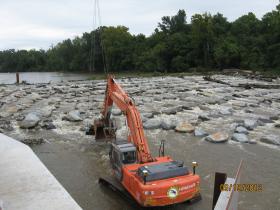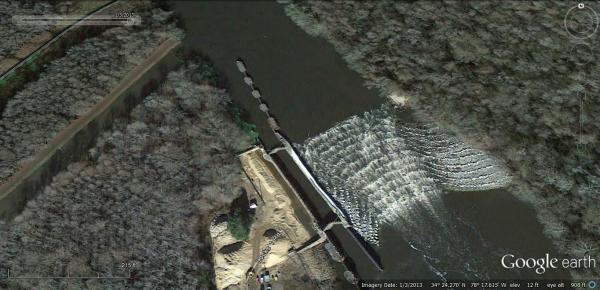Trade practices around the port city of Wilmington over the past century have caused a significant decline in the number of fish in the Cape Fear River. But thanks to the efforts of a local non-profit, their populations are staging a comeback. Cape Fear River Watch Riverkeeper Kemp Burdette says there are several reasons why the fish numbers have dropped, but main reason is the construction of three dams on Cape Fear River in the early 1900’s. The dams were originally built to facilitate trade and commerce along Cape Fear River between Wilmington to Fayetteville.
“Barges would approach the dam and would move into a lock chamber adjacent to the dam and that lock chamber would be flooded or drained depending on which way they were going and those boats would continue upstream.”
While the dams were beneficial for navigating barges and vessels, they prevented migrating fish species like striped bass, American shad, as well as the endangered Atlantic sturgeon and short nose sturgeon from swimming upstream to spawn during the spring.
“The American shad for instance, we are basically at 10 percent of what historic levels were. Nine out of every ten fish that used to be in the Cape Fear River are not there now. But none of these fish, none of these migratory species are even approaching the population numbers that would be considered healthy. So, they all need help.”
To help restore the natural migration of fish in the Cape Fear River, the Army Corps of Engineers constructed of a fish ladder at Lock and Dam one in Reigelwood last year. It’s the first one of its kind on the east coast of the United States. Fish climb the stair-step like structure made from carefully placed rocks by leaping out of the water, level by level, until they’re over the twelve foot high dam. It’s the first migrating season since the fish ladder has been in place, and Burdette says it’s being used.
“The Division of Marine Fisheries has tagged fish with sonic tags then they’ve gone out and collected this data and these studies show these fish are using these fish passages, striped bass and shad are both using these fish passages, they’re both moving upstream unassisted for basically the first time in one hundred years so it’s really a significant breakthrough for the Cape Fear River and the migratory fish in the Cape Fear River.”
Now two more Cape Fear fish ladders are in the planning phase. Two grant applications were recently submitted to the National and Oceanic and Atmospheric Administration to fund the design, construct, and monitor rock ramp fish ladders at the other dams on the Cape Fear River.
While one project focuses on helping migrating fish travel upstream, another project in the works will help restore breeding habitat. Coastal Scientist Dawn York explains the project.
“Basically, the premise is to design a site where we can place about 1,000 tons of rocks down in an area that will help enhance spawning habitat for American shad.”
York is with Dial Cordy and Associates, an independent environmental consulting firm working with the Cape Fear River Watch as well as state and federal agencies on creating the fish habitat. She says the rocks will be placed at a half-acre area downstream of lock and dam 2. An exact location for the habitat hasn’t been decided. Crushed granite, ranging in size from 2 to 10 inches, will be set at the bottom of the Cape Fear River providing a safe place for striped bass, herring, and sturgeon to lay their eggs. York says a dredging company in Wilmington will help facilitate the construction.
“They’ll travel up river it’ll take about 4-5 days to mobilize to lock and dam 2. They’ll use their excavator and smaller equipment to get the material onto a barge and they can handle about 90 tons per day. So we’re anticipating the construction of the restoration of habitat will take about 4 to 6 weeks.”
York says they want the first and last ton of granite material to be hand tossed into the water by volunteers.
“The rest of it would then be handled by the barge and mechanical means, basically an arm that will come down and grab large handfuls of material and place it into the river. It’s going to be sort of spaced out over a half acre, so it’s sort of a flat area.”
Construction should take place between December of this year and February 2014. The project can’t begin sooner because of a moratorium banning the placement of material in the water due to fish migration. Cape Fear River Watch Riverkeeper Kemp Burdette says the next several months will be spent finding the best location for the new fish habitat.
“It’s not nearly as simple as taking rock out there and dumping it off. What we’re really going to do is side scan assessments of the riverbed and what we’re trying to do there is understand what the riverbed looks like and what the substrate looks like and identify the best places to put the granite.”
Even with the project wrapping up in early 2014, Burdette says their work repopulating the waters of Cape Fear River with migrating fish species is far from over.
“The project at lock and dam number one was a huge first step, but it’s not the last step. We still have two more dams we need to have fish passage around because we really need these fish to get up into the fall line, that’s the area where they want to spawn, that’s the area where spawning would be most successful and so that’s where we need to go.”
Even though the construction isn’t underway, the project is already receiving national attention. The National Fish Habitat Partnership has listed the Cape Fear River as one of the “10 Waters to Watch,” for its locally driven conservation areas and ongoing efforts.
Fishing is permitted at all three lock and dam sites, however, there is a moratorium on keeping striped bass. It is illegal to keep sturgeon because they are an endangered species. A dock was recently installed at lock and dam number one downstream from the dam structure and Burdette says it’s a popular fishing site for shad. If you’d like to see a picture of the fish ladder in place at lock and dam one in Reigelwood, go to publicradioeast.org.
For more on Cape Fear River Watches fishery restoration efforts, click here: http://www.capefearriverwatch.org/advocacy/fish-restorationBy JARED BRUMBAUGH



